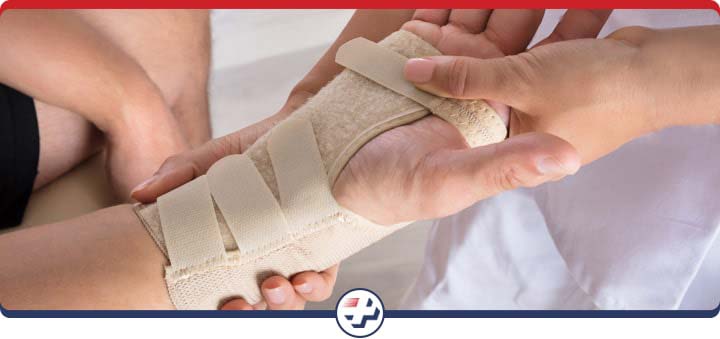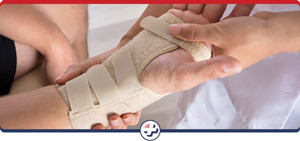Splinting Treatment Clinic in Florida
Elevate your recovery with splinting treatment, a specialized solution crafted for support and stability. Designed to aid in fractures, injuries, and orthopedic conditions, our splints provide optimal comfort for a swifter recovery. The duration varies and is tailored by our professionals to ensure precision in your healing journey. Experience the power of purposeful splinting for a swifter and more effective recovery. For more information, please contact us or request an appointment online. We have convenient locations to serve you in Parrish FL, Bradenton FL, Lithia FL, Sarasota FL, Lehigh Acres FL, Estero FL, Port Charlotte FL, West Bradenton FL, and Ellenton FL.


Table of Contents:
What is a medical treatment splint?
What is the main purpose of splinting?
Do splints help to heal?
How long should a splint stay on?
What are the four types of splints?
In medical treatment, a medical splint is a specialized device or material used in healthcare to immobilize and provide support for injured or unstable parts of the body, such as limbs, joints, or bones.
Splints are highly effective at minimizing movement in the affected area thus avoiding further damage while facilitating healing processes at the same time. Some can be customized according to an individual’s anatomy and others available ready-made for common injuries, making splints a key component in the recovery process from a range of injuries.
The main aim of putting on a splint in terms of medical treatment is to stabilize injured or unstable parts of the body, mostly limbs or joints. By doing this stability is maintained, reducing the chances of further injury and allowing natural healing processes to take place.
They are commonly used to relieve pain and discomfort caused by injuries. In addition, these devices also prevent unnecessary movement, which could lead to more pain being inflicted upon damaged tissues when one tries moving around with broken bones.
Splinting also plays an important role when it comes to preventing additional injury, especially after an accident where fractures occur because at any point some movements might aggravate things thereby worsening damages already done.
Splints also help in rehabilitation as during this period one may be able to engage in controlled movements or activities that facilitate recovery without risking additional harm. Physical therapy forms part of most treatment plans, and splinting plays a vital role in helping patients participate.
Splints play a very significant role in enhancing healing processes. For instance, their ability to immobilize and provide support for injured or damaged body parts greatly contributes to innate recovery mechanisms within human bodies.
Splinting helps reduce pain and discomfort resulting from injuries thereby enabling patients to rest comfortably, which is an important element during the treatment period. They serve as protective barriers preventing further damages that could hinder or delay healing since once any part gets hurt there should not be any movement taking place around the same region. Additionally, stability is assured, and correct positioning is maintained for proper healing processes.
It depends on various factors including the type severity of injury specific body parts involved, and recommendations given by health care providers. Temporary splinting will often be used for short periods which usually last a few days up to a few weeks and are mainly aimed at stabilizing an area that has been injured. If you have a broken bone that needs to heal, you may need to keep a splint on for a longer period. How long it takes depends on what kind of bone it is and how fast it gets better.
The duration of splint use should be closely followed by patients, according to their healthcare provider at PrimeHealth Urgent Care’s advice. If removed prematurely, the splint could lead to complications or slow down healing, while leaving it on for too long might interfere with efforts toward recovery. Therefore, regular check-ups need to be done for proper adjustment or removal when necessary.
In medical treatment, different kinds of splints are used depending on specific injuries or conditions being treated.
Soft splints, primarily made of padded fabric or foam material, are used when support is needed without full immobilization, providing gentle cushioning and stabilization for injured parts, making them suitable for conditions like tendonitis or mild joint injuries.
In contrast, rigid splints, typically crafted from materials such as plaster or fiberglass, offer strong immobilization and are commonly used for fractures or severe injuries that require complete stabilization, keeping the injured area immobile to facilitate optimal healing.
Semi-rigid splints, meanwhile, provide a balance between flexibility and support and are often utilized for sprains, strains, and minor fractures; they restrict movement to some degree but still allow for controlled motion, making them ideal for cases that don’t necessitate total immobilization.
Lastly, functional splints are designed to enable restricted movements within an injured part while also providing support and protection. They are mainly used during rehabilitation to aid in mobility and muscle strengthening through therapy exercises. These splints are adjustable and versatile, catering to the specific needs of a patient’s treatment plan.
It is applied to a wounded or irritated area of the body to shield, support, or immobilize it. Splinting treatment is available at PrimeHealth Urgent Care. For more information, contact us or request an appointment online. We serve patients from Parrish FL, Bradenton FL, Sarasota FL, Lithia FL, Lehigh Acres FL, Estero FL, Ellenton FL, Port Charlotte FL, West Bradenton FL, Palmetto FL, Lakewood Ranch FL, Foxleigh FL, Venice FL, Fruitville FL, Wimauma FL, Balm FL, Fort Myers FL, Westminster FL, El Dorado Acres FL, Cascades FL, West Samoset FL, Memphis FL, Harbour Heights FL, Murdock FL, and surrounding cities.

Additional Services You May Need

Additional Services You May Need
• Abscesses
• Sports Injuries
• Bug & Animal Bites
• BV Testing
• COVID Testing
• Drug Testing
• EKG Testing
• Flu Testing/ Flu Vaccine
• Foreign Body Removal
• Laceration Repair
• Minor Burn Treatment
• Pelvic Exams
• Strep Testing
• STD Testing
• Fractures, Sprains, & Strains
• Splinting Treatment
• School & Sports Physicals
• TB Testing
• Tetanus Shot
• Urgent Care
• Vaccines
• Wound Care
• Work Injuries
• X-Ray
• Internal Lab Services
• Illness/Injury
• Occupational Medicine
• Employment Physicals
• Common Cold
• Auto Injuries
• Weight Loss
• Wegovy
• Mounjaro





